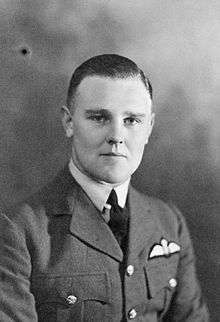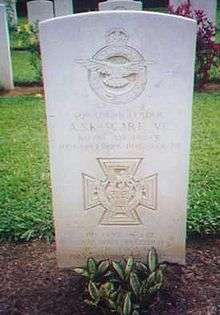Arthur Scarf
Squadron Leader Arthur Stewart King Scarf, VC (14 June 1913 – 9 December 1941) was a Royal Air Force pilot and a recipient of the Victoria Cross, the highest award for gallantry in the face of the enemy that can be awarded to British and Commonwealth forces.
Arthur Stewart King Scarf | |
|---|---|
 Arthur Scarf in RAF uniform | |
| Nickname(s) | Pongo[1] |
| Born | 14 June 1913 Wimbledon, London, England |
| Died | 9 December 1941 (aged 28) Alor Star, British Malaya |
| Buried | |
| Allegiance | United Kingdom |
| Service/ | Royal Air Force |
| Years of service | 1936–1941 |
| Rank | Squadron Leader |
| Unit | No. 62 Squadron RAF |
| Battles/wars | Second World War |
| Awards | Victoria Cross |
Early life and career
Scarf attended King's College School in Wimbledon, and was a RAF Cranwell trained regular. Scarf joined the Royal Air Force (RAF) in 1936, and was accepted for pilot training. On gaining his wings he was posted to No. 9 Squadron, operating the Handley Page Heyford. In 1937 he transferred to No. 62 Squadron, a light bomber unit which received the Bristol Blenheim in February 1938. Just prior to the outbreak of the Second World War in September 1939, the squadron was detached to bases in northern Malaya. From July 1941, No. 62 Squadron was based at Alor Star near the Thailand border and at the outbreak of hostilities with Japan in December 1941 the squadron came under heavy air attack. On 9 December it was withdrawn to RAF Butterworth in order to regroup.
Raid on Singora
Scarf was 28 years old, and a squadron leader in No. 62 Squadron, when the following deed took place for which he was awarded the Victoria Cross.
On 9 December 1941 in Malaya, near the Thailand border, all available aircraft had been ordered to make a daylight raid on Singora (where the Imperial Japanese Army was invading). Squadron Leader Scarf, as leader of the raid, had just taken off from the base at Butterworth when enemy aircraft swept in destroying or disabling all the rest of the machines. Scarf decided nevertheless to fly alone to Singora. Despite attacks from roving fighters he completed his bombing run and was on his way back when his aircraft became riddled with bullets and he was severely wounded, his left arm had been shattered, he had a large hole in his back and was drifting in and out of consciousness. He managed to crash-land the Blenheim at Alor Star, without causing any injury to his crew, and was rushed to hospital where he died two hours later.[2]
Scarf's Victoria Cross was not gazetted until June 1946. Because of the chaotic nature of the Malayan campaign, the facts concerning Scarf's actions were not known until after the war. At the time of his death he was about to become a father for the first time. His pregnant wife was a nurse based at the Alor Star hospital, but had just been evacuated south. The two other crewmen from Scarf's Blenheim were also given awards after the war for their courage during this action; Sergeant (later Squadron Leader) Paddy Calder was awarded a Distinguished Flying Medal and Sergeant Cyril Rich (killed in action in 1943) received a posthumous Mention in Despatches.
Scarf's Victoria Cross is displayed at the Royal Air Force Museum London, England.
 A Bristol Blenheim Mk I fighter believed to be from No. 27 Squadron at RAF Sembawang, Singapore, June 1941. Scarf's aircraft is now believed to be L1134 FX-F of No. 62 Squadron
A Bristol Blenheim Mk I fighter believed to be from No. 27 Squadron at RAF Sembawang, Singapore, June 1941. Scarf's aircraft is now believed to be L1134 FX-F of No. 62 Squadron Scarf's headstone at Taiping War Cemetery
Scarf's headstone at Taiping War Cemetery
References
- "Arthur S K Scarf VC". www.vconline.org.uk. Retrieved 25 November 2019.
- "No. 37623". The London Gazette (Supplement). 21 June 1946. p. 3211.